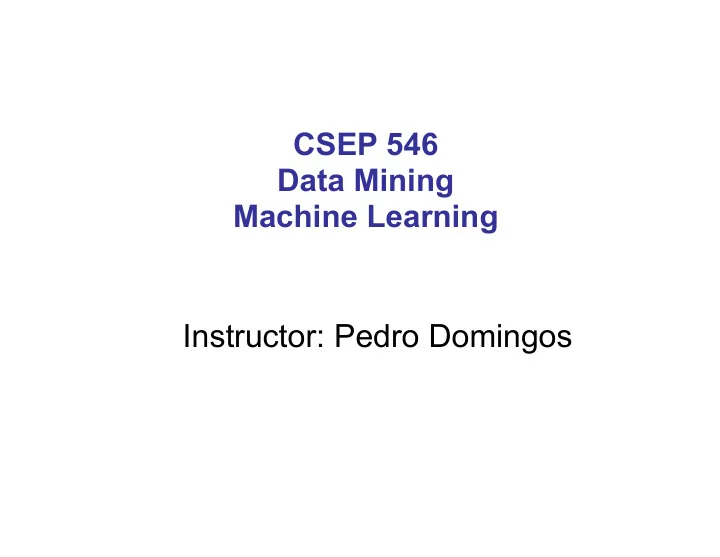

CSEP 546 Data Mining Machine Learning Instructor: Pedro Domingos
Logistics • Instructor: Pedro Domingos – Email: pedrod@cs – Office: CSE 648 – Office hours: Mondays 5:30-6:20 • TAs: Kenton Lee, Alon Milchgrub – Email: kentonl@cs, alonmil@cs – Office: CSE TBD – Office hours: Mondays 5:30-6:20 • Web: www.cs.washington.edu/csep546
Evaluation • Four assignments (25% each) – Handed out on weeks 2, 4, 6 and 8 – Due two weeks later – Mix of: • Implementing machine learning algorithms • Applying them to real datasets (e.g.: clickstream mining, recommender systems, spam filtering) • Exercises
Source Materials • T. Mitchell, Machine Learning , McGraw-Hill (Required) • R. Duda, P. Hart & D. Stork, Pattern Classification (2 nd ed.), Wiley (Required) • P. Domingos, The Master Algorithm , Basic Books (Recommended) • Papers
A Few Quotes • “A breakthrough in machine learning would be worth ten Microsofts” (Bill Gates, Founder, Microsoft) • “Machine learning is the next Internet” (Tony Tether, Director, DARPA) • Machine learning is the hot new thing” (John Hennessy, President, Stanford) • “Machine learning is Google’s top priority” (Eric Schmidt, Chairman, Alphabet) • “Machine learning is Microsoft Research’s largest investment area” (Peter Lee, Head, Microsoft Research) • “Machine learning is the single most important technology trend” (Steve Jurvetson, Partner, Draper Fisher Jurvetson) • “‘Data scientist’ is the hottest job title in Silicon Valley” (Tim O’Reilly, Founder, O’Reilly Media)
So What Is Machine Learning? • Automating automation • Getting computers to program themselves • Writing software is the bottleneck • Let the data do the work instead!
Traditional Programming Data Output Computer Program Machine Learning Data Program Computer Output
Magic? No, more like gardening • Seeds = Algorithms • Nutrients = Data • Gardener = You • Plants = Programs
Sample Applications • Web search • Computational biology • Finance • E-commerce • Space exploration • Robotics • Information extraction • Social networks • Debugging • [Your favorite area]
ML in a Nutshell • Tens of thousands of machine learning algorithms • Hundreds new every year • Every machine learning algorithm has three components: – Representation – Evaluation – Optimization
Representation • Decision trees • Sets of rules / Logic programs • Instances • Graphical models (Bayes/Markov nets) • Neural networks • Support vector machines • Model ensembles • Etc.
Evaluation • Accuracy • Precision and recall • Squared error • Likelihood • Posterior probability • Cost / Utility • Margin • Entropy • K-L divergence • Etc.
Optimization • Combinatorial optimization – E.g.: Greedy search • Convex optimization – E.g.: Gradient descent • Constrained optimization – E.g.: Linear programming
Types of Learning • Supervised (inductive) learning – Training data includes desired outputs • Unsupervised learning – Training data does not include desired outputs • Semi-supervised learning – Training data includes a few desired outputs • Reinforcement learning – Rewards from sequence of actions
Inductive Learning • Given examples of a function (X, F(X)) • Predict function F(X) for new examples X – Discrete F(X) : Classification – Continuous F(X) : Regression – F(X) = Probability( X ): Probability estimation
What We’ll Cover • Supervised learning – Decision tree induction – Rule induction – Instance-based learning – Bayesian learning – Neural networks – Support vector machines – Model ensembles – Learning theory • Unsupervised learning – Clustering – Dimensionality reduction
ML in Practice • Understanding domain, prior knowledge, and goals • Data integration, selection, cleaning, pre-processing, etc. • Learning models • Interpreting results • Consolidating and deploying discovered knowledge • Loop
Recommend
More recommend